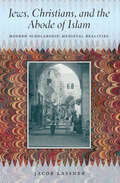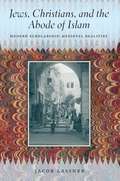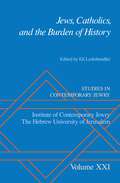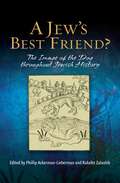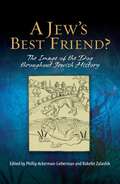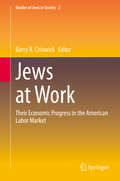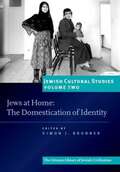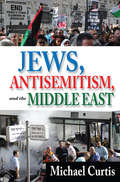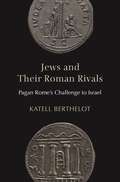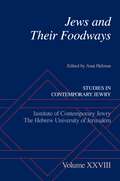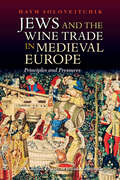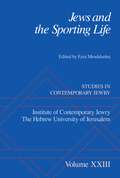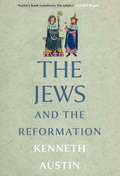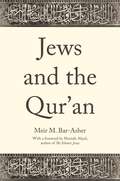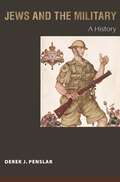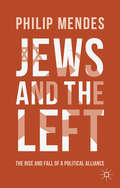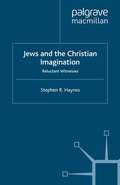- Table View
- List View
Jews, Christians, and the Abode of Islam: Modern Scholarship, Medieval Realities
by Jacob LassnerIn Jews, Christians, and the Abode of Islam, Jacob Lassner examines the triangular relationship that during the Middle Ages defined—and continues to define today—the political and cultural interaction among the three Abrahamic faiths. Lassner looks closely at the debates occasioned by modern Western scholarship on Islam to throw new light on the social and political status of medieval Jews and Christians in various Islamic lands from the seventh to the thirteenth century. Utilizing a vast array of primary sources, Lassner balances the rhetoric of literary and legal texts from the Middle Ages with other, newly discovered medieval sources that describe life as it was actually lived among the three faith communities. Lassner shows just what medieval Muslims meant when they spoke of tolerance, and how that abstract concept played out at different times and places in the real world of Christian and Jewish communities under Islamic rule. Finally, he considers what a more informed picture of the relationship among the Abrahamic faiths in the medieval Islamic world might mean for modern scholarship on medieval Islamic civilization and, not the least, for the highly contentious global environment of today.
Jews, Christians, and the Abode of Islam: Modern Scholarship, Medieval Realities
by Jacob LassnerIn Jews, Christians, and the Abode of Islam, Jacob Lassner examines the triangular relationship that during the Middle Ages defined—and continues to define today—the political and cultural interaction among the three Abrahamic faiths. Lassner looks closely at the debates occasioned by modern Western scholarship on Islam to throw new light on the social and political status of medieval Jews and Christians in various Islamic lands from the seventh to the thirteenth century. Utilizing a vast array of primary sources, Lassner balances the rhetoric of literary and legal texts from the Middle Ages with other, newly discovered medieval sources that describe life as it was actually lived among the three faith communities. Lassner shows just what medieval Muslims meant when they spoke of tolerance, and how that abstract concept played out at different times and places in the real world of Christian and Jewish communities under Islamic rule. Finally, he considers what a more informed picture of the relationship among the Abrahamic faiths in the medieval Islamic world might mean for modern scholarship on medieval Islamic civilization and, not the least, for the highly contentious global environment of today.
Jews, Christians, and the Abode of Islam: Modern Scholarship, Medieval Realities
by Jacob LassnerIn Jews, Christians, and the Abode of Islam, Jacob Lassner examines the triangular relationship that during the Middle Ages defined—and continues to define today—the political and cultural interaction among the three Abrahamic faiths. Lassner looks closely at the debates occasioned by modern Western scholarship on Islam to throw new light on the social and political status of medieval Jews and Christians in various Islamic lands from the seventh to the thirteenth century. Utilizing a vast array of primary sources, Lassner balances the rhetoric of literary and legal texts from the Middle Ages with other, newly discovered medieval sources that describe life as it was actually lived among the three faith communities. Lassner shows just what medieval Muslims meant when they spoke of tolerance, and how that abstract concept played out at different times and places in the real world of Christian and Jewish communities under Islamic rule. Finally, he considers what a more informed picture of the relationship among the Abrahamic faiths in the medieval Islamic world might mean for modern scholarship on medieval Islamic civilization and, not the least, for the highly contentious global environment of today.
Jews, Christians, and the Abode of Islam: Modern Scholarship, Medieval Realities
by Jacob LassnerIn Jews, Christians, and the Abode of Islam, Jacob Lassner examines the triangular relationship that during the Middle Ages defined—and continues to define today—the political and cultural interaction among the three Abrahamic faiths. Lassner looks closely at the debates occasioned by modern Western scholarship on Islam to throw new light on the social and political status of medieval Jews and Christians in various Islamic lands from the seventh to the thirteenth century. Utilizing a vast array of primary sources, Lassner balances the rhetoric of literary and legal texts from the Middle Ages with other, newly discovered medieval sources that describe life as it was actually lived among the three faith communities. Lassner shows just what medieval Muslims meant when they spoke of tolerance, and how that abstract concept played out at different times and places in the real world of Christian and Jewish communities under Islamic rule. Finally, he considers what a more informed picture of the relationship among the Abrahamic faiths in the medieval Islamic world might mean for modern scholarship on medieval Islamic civilization and, not the least, for the highly contentious global environment of today.
Jews, Catholics, and the Burden of History (Studies in Contemporary Jewry #Vol. XXI)
by Eli LederhendlerVolume XXI of the distinguished annual Studies in Contemporary Jewry marks sixty years since the end of the Second World War and forty years since the Second Vatican Council's efforts to revamp Church relations with the Jewish people and the Jewish faith. Jews, Catholics, and the Burden of History offers a collection of new scholarship on the nature of the Jewish-Catholic encounter between 1945 and 2005, with an emphasis on how this relationship has emerged from the shadow of the Holocaust.
Jews, Catholics, and the Burden of History (Studies in Contemporary Jewry #Vol. XXI)
by Eli LederhendlerVolume XXI of the distinguished annual Studies in Contemporary Jewry marks sixty years since the end of the Second World War and forty years since the Second Vatican Council's efforts to revamp Church relations with the Jewish people and the Jewish faith. Jews, Catholics, and the Burden of History offers a collection of new scholarship on the nature of the Jewish-Catholic encounter between 1945 and 2005, with an emphasis on how this relationship has emerged from the shadow of the Holocaust.
A Jew's Best Friend?: The Image of the Dog Throughout Jewish History
by Phillip Ackerman-Lieberman Rakefet ZalashikThe dog has captured the Jewish imagination from antiquity to the contemporary period, with the image of the dog often used to characterise and demean Jewish populations in medieval Christendom. In the interwar period, dogs were still considered goyishe nakhes ("a gentile pleasure") and virtually unheard of in the Jewish homes of the shtetl. Yet Azit the Paratrooping Dog of modern Israeli cinema, one of many examples of dogs as heroes of the Zionist narrative, demonstrates that the dog has captured the contemporary Jewish imagination. The book discusses specific cultural manifestations of the relationship between dogs and Jews, from ancient times to the present. Covering a geographical range extending from the Middle East through Europe and to North America, the contributors -- all of whom are senior university scholars specializing in various disciplines -- provide a unique cross-cultural, trans-national, diachronic perspective. An important theme is the constant tension between domination/control and partnership which underpins the relationship of humans to animals, as well as the connection between Jewish societies and their broader host cultures. A public increasingly interested in cultural history in general and Jewish history in particular will benefit from the diverse perspectives provided herein. One need look no further than the popular media surrounding President Obama's choice of a canine companion: dog-owners and dog-lovers, and all those involved at university level with cultural studies, can deepen their understanding of the humancanine relationship by reading this volume.
A Jew's Best Friend?: The Image of the Dog Throughout Jewish History
by Phillip Ackerman-Lieberman Rakefet ZalashikThe dog has captured the Jewish imagination from antiquity to the contemporary period, with the image of the dog often used to characterise and demean Jewish populations in medieval Christendom. In the interwar period, dogs were still considered goyishe nakhes ("a gentile pleasure") and virtually unheard of in the Jewish homes of the shtetl. Yet Azit the Paratrooping Dog of modern Israeli cinema, one of many examples of dogs as heroes of the Zionist narrative, demonstrates that the dog has captured the contemporary Jewish imagination. The book discusses specific cultural manifestations of the relationship between dogs and Jews, from ancient times to the present. Covering a geographical range extending from the Middle East through Europe and to North America, the contributors -- all of whom are senior university scholars specializing in various disciplines -- provide a unique cross-cultural, trans-national, diachronic perspective. An important theme is the constant tension between domination/control and partnership which underpins the relationship of humans to animals, as well as the connection between Jewish societies and their broader host cultures. A public increasingly interested in cultural history in general and Jewish history in particular will benefit from the diverse perspectives provided herein. One need look no further than the popular media surrounding President Obama's choice of a canine companion: dog-owners and dog-lovers, and all those involved at university level with cultural studies, can deepen their understanding of the humancanine relationship by reading this volume.
Jews at Work: Their Economic Progress in the American Labor Market (Studies of Jews in Society #2)
by Barry R. ChiswickThis book addresses the educational, occupational, and income progress of Jews in the American labor market. Using theoretical and statistical findings, it compares the experience of American Jews with that of other Americans, from the middle of the 19th century through the 20th and into the early 21st century.Jews in the United States have been remarkably successful; from peddlers and low-skilled factory workers, clearly near the bottom of the economic ladder, they have, as a community, risen to the top of the economic ladder. The papers included in this volume, all authored or co-authored by Barry Chiswick, address such issues as the English language proficiency, occupational attainment and earnings of Jews, educational and labor market discrimination against Jews, life cycle and labor force participation patterns of Jewish women, and historical and methodological issues, among many others. The final chapter analyzes alternative explanations for the consistently high level of educational and economic achievement of American Jewry over the past century and a half. The chapters in this book also develop and demonstrate the usefulness of alternative techniques for identifying Jews in US Census and survey data where neither religion nor Jewish ethnicity is explicitly identified. This methodology is also applicable to the study of other minority groups in the US and in other countries.
Jews at Home: The Domestication of Identity (Jewish Cultural Studies #2)
by Simon J. BronnerFor a Jew, describing a place as 'home' conveys connotations of heritage as well as of residence. Additionally, feeling 'at home' suggests a sense of comfort in one's social surroundings. The questions at the heart of this volume are: what things make a home 'Jewish', materially and emotionally, and what is it that makes Jews feel 'at home' in their environment? The material dimensions are explored through a study of the symbolic and ritual objects that convey Jewishness and a consideration of other items that may be used to express Jewish identity in the home-something that the introduction identifies as 'living-room Judaism'. The discussion is geographically and ethnically wide-ranging, and the transformation of meaning attached to different objects in different environments is contextualized, as, for example, in Shalom Sabar's study of {h.}amsa amulets in Morocco and Israel. For diasporic Jewish culture, the question of feeling at home is an emotional issue that frequently emerges in literature, folklore, and the visual and performing arts. The phrase 'at-homeness in exile' aptly expresses the tension between the different heritages with which Jews identify, including that between the biblical promised land and the cultural locations from which Jewish migration emanated. The essays in this volume take a closer look at the way in which ideas about feeling at home as a Jew are expressed in literature originating in Brazil, Argentina, and the United States, and also at the political ramifications of these emotions. The question is further explored in a series of exchanges on the future of Jews feeling 'at home' in Australia, Germany, Israel, and the United States. Jews at Home is the first book to examine the theme of the Jewish home materially and emotionally from a variety of disciplinary perspectives, including literature, history, anthropology, sociology, psychology, art history, and folk and popular culture. The essays in the collection use the theme of home and the concept of domestication to revise understanding of the lived (and built) past, and to open new analytical possibilities for the future. Its discussion of domestic culture and its relevance to Jewish identity is one with which readers should feel right at home.
Jews, Antisemitism, and the Middle East
by Michael CurtisWill animosity towards Jews and the State of Israel never end? This book ventures to rectify the misrepresentations, propaganda, obsessions, and falsifications widely disseminated in the media and public discourse, explaining the motivations behind them. The issues Michael Curtis scrutinizes are complicated and controversial, sometimes even baffling, but he reviews them in as objective and rigorous a manner as possible. Curtis divides his arguments into five key areas: political correctness and the obsessive attack on Israel; the surprising and disturbing rise of antisemitism; the Arab world and the Islamist threat; the Palestinian narrative; and the Israeli/Palestinian conflict. The first section focuses on the censorious attitude toward Israel taken by many in the international community. A second section consists of essays on the increase of contemporary antisemitism in Arab and Muslim countries as well as European democracies. In the third section, the author addresses changes in the Arab world, the threat of Iranian ambitions, the new alliance of Sunni Islamist states, and the growing strength and danger of Islamic fundamentalism and extremist behavior. His fourth section, on the Palestinian Narrative, details the acceptance by many critics of Israel and the international media of the Palestinian narrative of victimhood. Finally, the section on the Israeli-Palestinian conflict details the continuing struggle within the Middle East between Israelis and Palestinians. This book is a must read for historians, political scientists, Jewish studies scholars, and all those interested in one of the most volatile and controversial regions in the world today.
Jews, Antisemitism, and the Middle East
by Michael CurtisWill animosity towards Jews and the State of Israel never end? This book ventures to rectify the misrepresentations, propaganda, obsessions, and falsifications widely disseminated in the media and public discourse, explaining the motivations behind them. The issues Michael Curtis scrutinizes are complicated and controversial, sometimes even baffling, but he reviews them in as objective and rigorous a manner as possible. Curtis divides his arguments into five key areas: political correctness and the obsessive attack on Israel; the surprising and disturbing rise of antisemitism; the Arab world and the Islamist threat; the Palestinian narrative; and the Israeli/Palestinian conflict. The first section focuses on the censorious attitude toward Israel taken by many in the international community. A second section consists of essays on the increase of contemporary antisemitism in Arab and Muslim countries as well as European democracies. In the third section, the author addresses changes in the Arab world, the threat of Iranian ambitions, the new alliance of Sunni Islamist states, and the growing strength and danger of Islamic fundamentalism and extremist behavior. His fourth section, on the Palestinian Narrative, details the acceptance by many critics of Israel and the international media of the Palestinian narrative of victimhood. Finally, the section on the Israeli-Palestinian conflict details the continuing struggle within the Middle East between Israelis and Palestinians. This book is a must read for historians, political scientists, Jewish studies scholars, and all those interested in one of the most volatile and controversial regions in the world today.
Jews and Their Roman Rivals: Pagan Rome's Challenge to Israel
by Katell BerthelotHow encounters with the Roman Empire compelled the Jews of antiquity to rethink their conceptions of Israel and the TorahThroughout their history, Jews have lived under a succession of imperial powers, from Assyria and Babylonia to Persia and the Hellenistic kingdoms. Jews and Their Roman Rivals shows how the Roman Empire posed a unique challenge to Jewish thinkers such as Philo, Josephus, and the Palestinian rabbis, who both resisted and internalized Roman standards and imperial ideology.Katell Berthelot traces how, long before the empire became Christian, Jews came to perceive Israel and Rome as rivals competing for supremacy. Both considered their laws to be the most perfect ever written, and both believed they were a most pious people who had been entrusted with a divine mission to bring order and peace to the world. Berthelot argues that the rabbinic identification of Rome with Esau, Israel's twin brother, reflected this sense of rivalry. She discusses how this challenge transformed ancient Jewish ideas about military power and the use of force, law and jurisdiction, and membership in the people of Israel. Berthelot argues that Jewish thinkers imitated the Romans in some cases and proposed competing models in others.Shedding new light on Jewish thought in antiquity, Jews and Their Roman Rivals reveals how Jewish encounters with pagan Rome gave rise to crucial evolutions in the ways Jews conceptualized the Torah and conversion to Judaism.
Jews and Their Foodways (Studies in Contemporary Jewry)
by Anat HelmanFood is not just a physical necessity but also a composite commodity. It is part of a communication system, a nonverbal medium for expression, and a marker of special events. Bringing together contributions from fourteen historians, anthropologists, sociologists, and literary critics, Volume XXVIII of Studies in Contemporary Jewry presents various viewpoints on the subtle and intricate relations between Jews and their foodways. The ancient Jewish community ritualized and codified the sphere of food; by regulating specific and detailed culinary laws, Judaism extended and accentuated food's cultural meanings. Modern Jewry is no longer defined exclusively in religious terms, yet a decrease in the role of religion, including kashrut observance, does not necessarily entail any diminishment of the role of food. On the contrary, as shown by the essays in this volume, choices of food take on special importance when Jewish individuals and communities face the challenges of modernity. Following an introduction by Sidney Mintz and concluding with an overview by Richard Wilk, the symposium essays lead the reader from the 20th century to the 21st, across Europe, the Middle East, Africa, and North America. Through periods of war and peace, voluntary immigrations and forced deportations, want and abundance, contemporary Jews use food both for demarcating new borders in rapidly changing circumstances and for remembering a diverse heritage. Despite a tendency in traditional Jewish studies to focus on "high" culture and to marginalize "low" culture, Jews and Their Foodways demonstrates how an examination of people's eating habits helps to explain human life and its diversity through no less than the study of great events, the deeds of famous people, and the writings of distinguished rabbis.
Jews and Their Foodways (Studies in Contemporary Jewry)
Food is not just a physical necessity but also a composite commodity. It is part of a communication system, a nonverbal medium for expression, and a marker of special events. Bringing together contributions from fourteen historians, anthropologists, sociologists, and literary critics, Volume XXVIII of Studies in Contemporary Jewry presents various viewpoints on the subtle and intricate relations between Jews and their foodways. The ancient Jewish community ritualized and codified the sphere of food; by regulating specific and detailed culinary laws, Judaism extended and accentuated food's cultural meanings. Modern Jewry is no longer defined exclusively in religious terms, yet a decrease in the role of religion, including kashrut observance, does not necessarily entail any diminishment of the role of food. On the contrary, as shown by the essays in this volume, choices of food take on special importance when Jewish individuals and communities face the challenges of modernity. Following an introduction by Sidney Mintz and concluding with an overview by Richard Wilk, the symposium essays lead the reader from the 20th century to the 21st, across Europe, the Middle East, Africa, and North America. Through periods of war and peace, voluntary immigrations and forced deportations, want and abundance, contemporary Jews use food both for demarcating new borders in rapidly changing circumstances and for remembering a diverse heritage. Despite a tendency in traditional Jewish studies to focus on "high" culture and to marginalize "low" culture, Jews and Their Foodways demonstrates how an examination of people's eating habits helps to explain human life and its diversity through no less than the study of great events, the deeds of famous people, and the writings of distinguished rabbis.
Jews and the Wine Trade in Medieval Europe: Principles and Pressures (The Littman Library of Jewish Civilization)
by Haym SoloveitchikAlthough Jews were at the centre of commercial activity in medieval Europe, a talmudic ban on any wine touched by a Gentile prevented them from engaging in the lucrative wine trade. Wine was consumed in vast quantities in the Middle Ages, and the banks of the Rhineland hosted some of the finest vineyards in northern Europe. German Jews were, until the thirteenth century, a merchant class. How could they abstain from trading in one of the region’s major commodities? In time, they ruled that it was permissible to accept wine in payment of debt, but forbade trading in it, and they maintained that ban throughout the Middle Ages. Further study in the twelfth century, however, led Talmudists to discover that Jews were only forbidden to profit from trading in Gentile wine if they dealt with idolaters, but that trade with Christians and Muslims was permitted. Nevertheless, the German community refused to take advantage of this clear licence. Using Jewish and Gentile sources, this study probes the sources of this powerful taboo. In describing the complex ways in which deeply held cultural values affect Jews’ engagement in the economy of the surrounding society, this book also illustrates the law of unintended consequences—how the ban on Gentile wine led both to a major Jewish contribution to German viticulture and to the involvement of Jews in moneylending, with all its tragic consequences.
Jews and the Wine Trade in Medieval Europe: Principles and Pressures (The Littman Library of Jewish Civilization)
by Haym SoloveitchikAlthough Jews were at the centre of commercial activity in medieval Europe, a talmudic ban on any wine touched by a Gentile prevented them from engaging in the lucrative wine trade. Wine was consumed in vast quantities in the Middle Ages, and the banks of the Rhineland hosted some of the finest vineyards in northern Europe. German Jews were, until the thirteenth century, a merchant class. How could they abstain from trading in one of the region’s major commodities? In time, they ruled that it was permissible to accept wine in payment of debt, but forbade trading in it, and they maintained that ban throughout the Middle Ages. Further study in the twelfth century, however, led Talmudists to discover that Jews were only forbidden to profit from trading in Gentile wine if they dealt with idolaters, but that trade with Christians and Muslims was permitted. Nevertheless, the German community refused to take advantage of this clear licence. Using Jewish and Gentile sources, this study probes the sources of this powerful taboo. In describing the complex ways in which deeply held cultural values affect Jews’ engagement in the economy of the surrounding society, this book also illustrates the law of unintended consequences—how the ban on Gentile wine led both to a major Jewish contribution to German viticulture and to the involvement of Jews in moneylending, with all its tragic consequences.
Jews and the Sporting Life: Studies in Contemporary Jewry XXIII (Studies in Contemporary Jewry #XXIII)
by Ezra MendelsohnVolume XXIII of the distinguished annual Studies in Contemporary Jewry explores the role of sports in modern Jewish history. The centrality of sports in modern life--in popular and even in high culture, in economic life, in the media, in international and national politics, and in forging ethnic identities--can hardly be exaggerated, but in the field of Jewish studies this subject has been somewhat neglected, at least until recently. Students of American Jewish history, for example, often emphasize the role of sports in the Americanization of the immigrants, while students of Jewish nationalism pay closer attention to its appeal for the regeneration of the Jewish nation, as well as the creation of a new, healthy, Jewish body. The essays brought together in Jews and the Sporting Life expand the body of knowledge about the place sports occupied, and continue to occupy, in Jewish life. They examine the connection between sports and Jewish nationalism, particularly Zionism, and how organized Jewish sports have been an agent of nation-building. They consider the role of Jews as owners of sports teams, as amateur and professional athletes, and as fans and bettors. Other themes include sports and Jewish literature, and boxing as a sport that enabled Jewish men to prove their masculinity in a world that often stereotyped them as weak and "feminine." This volume concentrates on twentieth century developments in Israel, Europe, and the United States.
Jews and the Sporting Life: Studies in Contemporary Jewry XXIII (Studies in Contemporary Jewry #XXIII)
by Ezra MendelsohnVolume XXIII of the distinguished annual Studies in Contemporary Jewry explores the role of sports in modern Jewish history. The centrality of sports in modern life--in popular and even in high culture, in economic life, in the media, in international and national politics, and in forging ethnic identities--can hardly be exaggerated, but in the field of Jewish studies this subject has been somewhat neglected, at least until recently. Students of American Jewish history, for example, often emphasize the role of sports in the Americanization of the immigrants, while students of Jewish nationalism pay closer attention to its appeal for the regeneration of the Jewish nation, as well as the creation of a new, healthy, Jewish body. The essays brought together in Jews and the Sporting Life expand the body of knowledge about the place sports occupied, and continue to occupy, in Jewish life. They examine the connection between sports and Jewish nationalism, particularly Zionism, and how organized Jewish sports have been an agent of nation-building. They consider the role of Jews as owners of sports teams, as amateur and professional athletes, and as fans and bettors. Other themes include sports and Jewish literature, and boxing as a sport that enabled Jewish men to prove their masculinity in a world that often stereotyped them as weak and "feminine." This volume concentrates on twentieth century developments in Israel, Europe, and the United States.
The Jews and the Reformation
by Kenneth AustinJudaism has always been of great significance to Christianity but this relationship has also been marked by complexity and ambivalence. The emergence of new Protestant confessions in the Reformation had significant consequences for how Jews were viewed and treated. In this wide-ranging account, Kenneth Austin examines Christian attitudes toward Jews, the Hebrew language, and Jewish learning, arguing that they have much to tell us about the Reformation and its priorities—and have important implications for how we think about religious pluralism today.
Jews and the Qur'an
by Meir M. Bar-AsherA compelling book that casts the Qur’anic encounter with Jews in an entirely new lightIn this panoramic and multifaceted book, Meir Bar-Asher examines how Jews and Judaism are depicted in the Qur’an and later Islamic literature, providing needed context to those passages critical of Jews that are most often invoked to divide Muslims and Jews or to promote Islamophobia. He traces the Qur’anic origins of the protection of Jews and other minorities living under the rule of Islam, and shows how attitudes toward Jews in Shi‘i Islam are substantially different from those in Sunni Islam. Bar-Asher sheds light on the extraordinary contribution of Jewish tradition to the Muslim exegesis of the Qur’an, and draws important parallels between Jewish religious law, or halakha, and shari‘a law.An illuminating work on a topic of vital relevance today, Jews and the Qur’an offers a nuanced understanding of Islam’s engagement with Judaism in the time of Muhammad and his followers, and serves as a needed corrective to common misperceptions about Islam.
Jews and the Military: A History
by Derek J. PenslarJews and the Military is the first comprehensive and comparative look at Jews' involvement in the military and their attitudes toward war from the 1600s until the creation of the state of Israel in 1948. Derek Penslar shows that although Jews have often been described as people who shun the army, in fact they have frequently been willing, even eager, to do military service, and only a minuscule minority have been pacifists. Penslar demonstrates that Israel's military ethos did not emerge from a vacuum and that long before the state's establishment, Jews had a vested interest in military affairs. Spanning Europe, North America, and the Middle East, Penslar discusses the myths and realities of Jewish draft dodging, how Jews reacted to facing their coreligionists in battle, the careers of Jewish officers and their reception in the Jewish community, the effects of World War I on Jewish veterans, and Jewish participation in the Spanish Civil War and World War II. Penslar culminates with a study of Israel's War of Independence as a Jewish world war, which drew on the military expertise and financial support of a mobilized, global Jewish community. He considers how military service was a central issue in debates about Jewish emancipation and a primary indicator of the position of Jews in any given society. Deconstructing old stereotypes, Jews and the Military radically transforms our understanding of Jews' historic relationship to war and military power.
Jews and the Military: A History
by Derek J. PenslarJews and the Military is the first comprehensive and comparative look at Jews' involvement in the military and their attitudes toward war from the 1600s until the creation of the state of Israel in 1948. Derek Penslar shows that although Jews have often been described as people who shun the army, in fact they have frequently been willing, even eager, to do military service, and only a minuscule minority have been pacifists. Penslar demonstrates that Israel's military ethos did not emerge from a vacuum and that long before the state's establishment, Jews had a vested interest in military affairs. Spanning Europe, North America, and the Middle East, Penslar discusses the myths and realities of Jewish draft dodging, how Jews reacted to facing their coreligionists in battle, the careers of Jewish officers and their reception in the Jewish community, the effects of World War I on Jewish veterans, and Jewish participation in the Spanish Civil War and World War II. Penslar culminates with a study of Israel's War of Independence as a Jewish world war, which drew on the military expertise and financial support of a mobilized, global Jewish community. He considers how military service was a central issue in debates about Jewish emancipation and a primary indicator of the position of Jews in any given society. Deconstructing old stereotypes, Jews and the Military radically transforms our understanding of Jews' historic relationship to war and military power.
Jews and the Left: The Rise and Fall of a Political Alliance
by P. MendesThe historical involvement of Jews in the political Left is well known, but far less attention has been paid to the political and ideological factors which attracted Jews to the Left. After the Holocaust and the creation of Israel many lost their faith in universalistic solutions, yet lingering links between Jews and the Left continue to exist.
Jews and the Christian Imagination: Reluctant Witnesses (Studies in Literature and Religion)
by S. HaynesReluctant Witnesses: Jews and the Christian Imagination is an analysis of the ancient Christian myth that casts Jews as a 'witness-people', and this myth's presence in contemporary religious discourse. It treats diverse products of the Christian imagination, including systematic theology, works of fiction, and popular writings on biblical prophecy. The book demonstrates that the witness-people myth, which was first articulated by Augustine and which determined official attitudes towards Jews in medieval Christendom, remains a powerful force in the Christian imagination.
